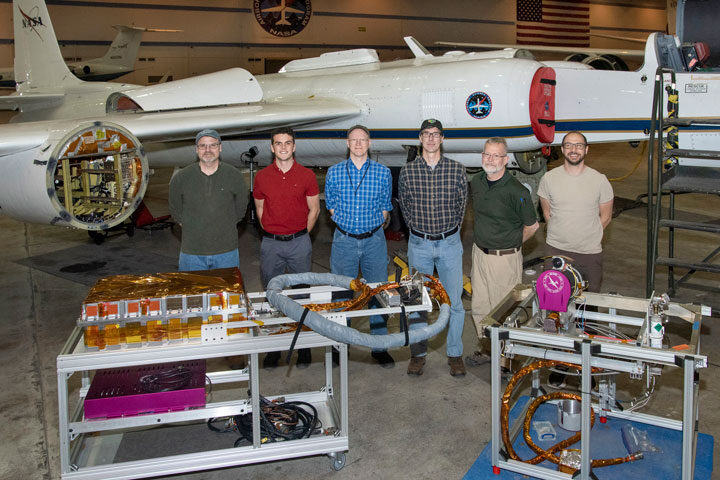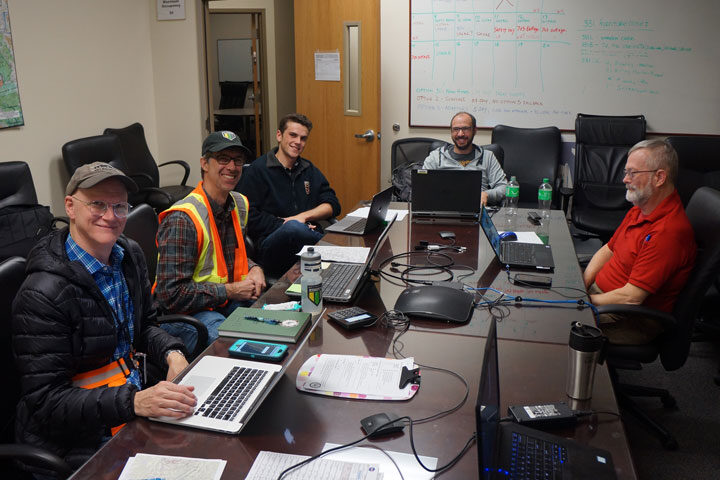


We had another successful flight last night. Airborne science has taught me that a great flight is one that provides good data and a story, but a perfect flight offers a story from which we learn something.
Let me back up. For the past two and a half years, my team from NASA, NIST, USGS, UMBC/JCET and the University of Guelph have been designing and building an instrument to take accurate measurements of the Moon to improve Earth observing sensors. After many long days, late nights, coffees, and a couple of successful test flights last year, we finally got to see our instrument, called air-LUSI, demonstrate its capabilities aboard an ER-2 airplane out of NASA’s Armstrong Flight Research Center (AFRC) in Palmdale, California. Our two-hour night flights started late November 12 and will wrap up on November 17 at around 2 a.m. in the morning.
The second night was a perfect flight. Preflight checks and takeoff were uneventful and the ER-2 ascended to 69,000 ft in about 45 minutes. The pilot then lined up the aircraft for our lunar observation flight line, which consists of a series of way points designed to keep the true heading perpendicular to the direction of the Moon.
At the time, I was sitting in the chase car with the mobile pilot and my Co-I, John Woodward. The ER-2 is difficult to fly. The cockpit is small and pilot is wearing a bulky spacesuit and helmet, so visibility is limited. The mobile pilot’s job is to help guide the ER-2 pilot, providing and extra pair of eyes and acts as point man for communication between the science team and ER-2 pilot. Chasing the plane down the runway was exciting and we know that racing just behind the plane as it lands will be even more thrilling. But now we were waiting for the experiment to unfold and do its job. The Moon was high and bright over the Mojave Desert and the November night air was dry but pleasantly cool. We quietly watched the flight using the Airborne Science Program (ASP) tracker on our cellphones and occasionally commented on the flight’s progress. I am also getting a play by play of our instruments performance via text from the rest of the air-LUSI team back in our mini mission control room.

At the beginning of run, the pilot deployed the telescope as planned and the IRIS telescope moved to the dorsal view port on the right wing pod.
Everything was working perfectly. And then the story began.
Within seconds of the telescope’s deployment, my team urgently texted and called me. They were clearly panicked. The autonomous robotic telescope mount instrument subsystem (ARTEMIS) tracking errors were through the roof. Something was terribly wrong.
Questions were quickly forming in my head, but before I could even ask, the voice on my cell, now on speaker, said, “Oh wait. The errors are back down to zero. We’re tracking!” “Good. Keep an eye on it and get back to me if there’s any change,” I said, and we hung up.
For the rest of the run, the ARTEMIS performed well, even better than the previous night. We didn’t realize it at the time, but that was new information.
On descent, the pilot radioed that he’d encountered a problem at the beginning of the data collection and would give details at the briefing. My entire team filed in the briefing room to hear that story.
The pilot had set the plane to autopilot and it became somewhat less stable, swaying back and forth. By the time he had worked out what had gone wrong and brought the plane back under manual control, several minutes had passed. He was genuinely concerned about what had happened to the data collection and so he flew an extra ten minutes to be sure that we got all 30 minutes like we had planned. He was relieved to hear that we got good measurements during that time.
Air-LUSI, naturally, had difficulty keeping a lock on the Moon while the plane was slaloming along, but recovered quickly when the flight smoothed out.
Once recovered, ARTEMIS’s tracking performance improved from the previous night. What made the difference?
Brian Hobbs, the ER-2 Mission Manager at AFRC, offered a hypothesis that seemed to resonate with the pilots, and it’s an idea that, I suspect, might not have emerged as readily if the autopilot mistake hadn’t happened on this flight.
It is simply this: air-LUSI’s tracking performance can be influenced by the pilot’s technique in targeting planned headings, even under normal conditions. We can tune our robotics to better account for handling nuances, like unexpected turbulence. We also learned that there are subtle oscillating motions of the aircraft that will also need to be tuned out to optimize our measurement accuracy. But, pilot technique can help reduce some of these effects.
Anyway, that’s three successful flights. Fly air-LUSI!